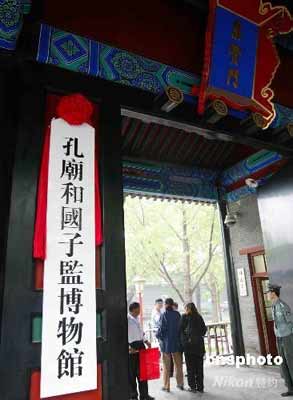Visitors from around the world can now leisurely savor China's traditional architectural beauty at the Imperial College in Beijing, about 400 years after the first foreign students were sent there to sit tough Chinese exams.
 The Imperial College re-opened on June 14, 2008,?after massive renovation.
The Imperial College re-opened on June 14, 2008,?after massive renovation.
The school and the adjacent Confucian Temple were formally re-opened on Saturday after three years' renovation.
The massive project, which cost 20 million yuan (2.9 million U.S. dollars), was the most extensive in the past 50 years. During the overhaul, many chambers were closed to visitors.
The project aimed to reinforce and repair the centuries-old structures while keeping them "as original as possible," said Yu Ping, vice head of the Beijing Municipal Administrations of Cultural Heritage.
"We did not repaint the ancient patterns on the beams or remove the faded glazed tiles on the roofs because we do not want to lose the antique flavor," she said.
After the face-lifts, the two sites are now basically what they were in olden times, in terms of the layout and scale, Yu added.
"The temple, which looks very authentic, is what I expected to see in China," said Vishal Shorma, a Singaporean tourist.
The Imperial College, or "Guozijian" in Chinese, was built in the early 14th century and served as the highest learning institution and education administration during the Yuan (1279-1368), Ming (1368-1644) and Qing (1644-1911) dynasties.
Chinese students, along with those from such places as India, Russia, Thailand and what is now the Democratic People's Republic of Korea, once studied Chinese culture and language there.
The Confucian Temple has served as a place to worship the ancient Chinese philosopher Confucius (551-479 BC) since its establishment in 1302.
The two cultural relics sites, located beside the Yonghe Lamasery, the largest in Beijing, were formally opened as an administrative unit, providing more Olympic tourists with insights into ancient China's Confucian worship and higher education.
They will serve as a "platform where the oriental and occidental cultures meet" during the Olympic Games in August, which is only 55 days away, said Zhao Dongming, director of the Cultural Activities Department of the Organizing Committee for the Beijing Olympic Games.
Every year, 4 million foreign tourists visit Beijing, a city with a 3,000-year history. It is estimated that more than 600,000 overseas visitors will swarm to the capital city during the 16-day sports gala, flooding its tourist spots.
"Based on decades of experience, we believe the best calling card for Beijing is traditional culture, rather than modernity," said Kong Fanzhi, head of the Beijing Municipal Administration of Cultural Heritage. The municipal government has spent about 5 billion yuan to maintain the city's 139 cultural relics sites over the past eight years.
(Xinhua News Agency June 15, 2008)